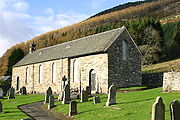
Dull, Perth and Kinross
Encyclopedia

Scotland
Scotland is a country that is part of the United Kingdom. Occupying the northern third of the island of Great Britain, it shares a border with England to the south and is bounded by the North Sea to the east, the Atlantic Ocean to the north and west, and the North Channel and Irish Sea to the...
. Situated in the Highland part of the county, Dull consists of a single street of houses on the north side of the valley of the River Tay
River Tay
The River Tay is the longest river in Scotland and the seventh-longest in the United Kingdom. The Tay originates in western Scotland on the slopes of Ben Lui , then flows easterly across the Highlands, through Loch Dochhart, Loch Lubhair and Loch Tay, then continues east through Strathtay , in...
. The place-name may mean 'meadow' in Gaelic. However, Duncan Campbell relates a traditional tale in "The Lairds of Glenlyon" (1886) which connects the Gaelic word 'dul' (snare) with the withies on the hearse of St Adomnán snapping, thus deciding his burial-place and the founding of Dull. The parish
Parish
A parish is a territorial unit historically under the pastoral care and clerical jurisdiction of one parish priest, who might be assisted in his pastoral duties by a curate or curates - also priests but not the parish priest - from a more or less central parish church with its associated organization...
church, unused since the 1970s , is on the site of an early Christian
Christian
A Christian is a person who adheres to Christianity, an Abrahamic, monotheistic religion based on the life and teachings of Jesus of Nazareth as recorded in the Canonical gospels and the letters of the New Testament...
monastery
Monastery
Monastery denotes the building, or complex of buildings, that houses a room reserved for prayer as well as the domestic quarters and workplace of monastics, whether monks or nuns, and whether living in community or alone .Monasteries may vary greatly in size – a small dwelling accommodating only...
founded by St Adomnán (Scottish Gaelic: N. Eònan), Abbot of Iona
Iona
Iona is a small island in the Inner Hebrides off the western coast of Scotland. It was a centre of Irish monasticism for four centuries and is today renowned for its tranquility and natural beauty. It is a popular tourist destination and a place for retreats...
(died 704). Several early Christian cross-slabs dating to the 7th or 8th century have been discovered in and around the parish graveyard. A slab carved with stylised warriors and horsemen in the Pictish style, uncovered during grave-digging in the 19th century, is displayed in the Museum of Scotland, and may have formed part of a wall-relief, or one side of a box-shrine. A massive font of rough workmanship, preserved by the church door, is also a probable relic from the early monastic site.
The surrounding district was known as the 'Appin of Dull', the name 'Appin' deriving from Old Irish apdaine, 'abbacy', referring to the former monastic estate. Compare Appin in Argyll
Argyll
Argyll , archaically Argyle , is a region of western Scotland corresponding with most of the part of ancient Dál Riata that was located on the island of Great Britain, and in a historical context can be used to mean the entire western coast between the Mull of Kintyre and Cape Wrath...
, the 'abbey lands' in that case being those of the major early Christian monastery of Lismore
Lismore
-Places:Australia*Lismore, New South Wales, city*Lismore, Victoria, townCanada*Lismore, Nova Scotia, villageIreland*Lismore, County Waterford, town*Lismore Castle*Lismore, County Down, a townland in County Down,Scotland*Lismore, Scotland, island...
. Four undecorated crosses, of which three survive, one at Dull itself, and two in the nearby old church at Weem
Weem
Weem is a village on the B846 near Aberfeldy in Perthshire, Scotland.The name Weem is derived from the Gaelic uaimh, meaning 'cave'....
, once stood around the monastic precinct, defining an area of sanctuary.
During the later Middle Ages
Middle Ages
The Middle Ages is a periodization of European history from the 5th century to the 15th century. The Middle Ages follows the fall of the Western Roman Empire in 476 and precedes the Early Modern Era. It is the middle period of a three-period division of Western history: Classic, Medieval and Modern...
, and up to modern times, the church at Dull was merely a parish church in the Diocese
Diocese
A diocese is the district or see under the supervision of a bishop. It is divided into parishes.An archdiocese is more significant than a diocese. An archdiocese is presided over by an archbishop whose see may have or had importance due to size or historical significance...
of Dunkeld
Dunkeld
Dunkeld is a small town in Strathtay, Perth and Kinross, Scotland. It is about 15 miles north of Perth on the eastern side of the A9 road into the Scottish Highlands and on the opposite side of the Tay from the Victorian village of Birnam. Dunkeld and Birnam share a railway station, on the...
. It is not known when the early Christian monastery ceased to function.
In decline for much of the 20th century, with its church and school both going out of use, the small village has seen the construction of several new houses, and the restoration of older buildings, in recent years.

